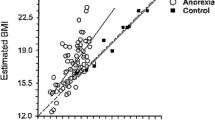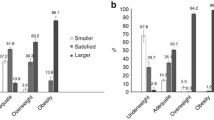Abstract
Recently, body dissatisfaction has been conceptualized as the discrepancy between self and ideal body size estimates. This study evaluated the validity of this conceptualization using three methods for estimating actual and ideal body size: (a) the Body Image Assessment, (b) the Body Image Testing System, and (c) the Body Image Detection Device. The three body image assessment procedures were concurrently administered to a sample of 110 women diagnosed: bulimia nervosa (n=18),obese (n=34),and non-eating disorder (n=58).The Eating Disorder Inventory Body Dissatisfaction scale was also used to measure body dissatisfaction. Measures of self-ideal body size discrepancy were found to correlate more highly with measures of body dissatisfaction than were measures of current body size perception, ideal body size, body size estimation accuracy, or indices based on actual body size. Estimation of both current and ideal body size were found to significantly predict overall body dissatisfaction; thus, both self and ideal body size measures were found to be significant components in determining body size dissatisfaction. These data were interpreted as supportive of the conceptualization of body dissatisfaction as the discrepancy between self and ideal body size estimates.
Similar content being viewed by others
References
American Psychiatric Association (1987).Diagnostic and statistical manual of mental disorders (3rd ed.-rev.). Washington, DC: APA.
Ben-Tovim, B. I., & Walker, M. K. (1991). Women's body attitudes: A review of measurementtechniques. International Journal of Eating Disorders, 10, 155–167.
Ben-Tovim, B. I., Walker, M. K., Murray, H., & Chin, G. (1990). Body size estimates: Body image or body attitude measures?International Journal of Eating Disorders, 9, 57–67.
Cash, T. F., & Brown, T. A. (1987). Body image in anorexia nervosa and bulimia nervosa.Behavioral Modification, 11, 487–521.
Cooper, P. S., & Taylor, M. J. (1988). Body image disturbance in bulimia nervosa.British Journal of Psychiatry, 153 (suppl. 2), 32–36.
Coovert, M. A., Thompson, J. K., & Kinder, B. N. (1988). Interrelationships among multiple aspects of body image and eating disturbance.International Journal of Eating Disorders, 7, 495–502.
Fichter, M. M., Meister, I., & Koch, H. J. (1986). The measurement of body image disturbances in anorexia nervosa.British Journal of Psychiatry, 148, 453–461.
Garner, D. M., & Garfinkel, P. E. (1979). The eating attitudes test: An index of the symptoms of anorexia nervosa.Psychological Medicine, 9, 273–279.
Garner, D. M., Olmstead, M. A., & Polivy, J. (1983). Development and validation of a multidimensional eating disorder inventory for anorexia nervosa and bulimia.International Journal of Eating Disorders, 2, 15–34.
Gleghorn, A. A., Penner, L. A., Powers, P. S., & Schulman, R. (1987). The psychometric properties of several measures of body image.Journal of Psychopalhology and Behavioral Assessment, 9, 203–218.
Guadagnoli, E., & Velicer, W. F. (1988). Relation of sample size to the stability of component patterns.Psychological Bulletin, 103, 265–275.
Keeton, W. P., Cash, T. F., & Brown, T. A. (1990). Body image or body images? Comparative, multidimensional assessment among college students.Journal of Personality Assessment, 54, 312–330.
Ruff, G. A., & Barrios, B. A. (1986). Realistic assessment of body image.Behavioral Assessment, 8, 237–251.
Schlundt, D. G., & Johnson, W. G. (1990).Assessment and treatment of anorexia and bulimia nervosa. Needham Heights, MA: Allyn & Bacon.
Smith, M. C., & Thelen, M. H. (1984). Development and validation of a test for bulimia.Journal of Consulting and Clinical Psychology, 52, 863–872.
Thompson, J. K. (1992). Body image: Extent of disturbance, associated features, theoretical models, assessment methodologies, and a proposal for a new DSM-IV diagnostic category — Body Image Disorder. In M. Hersen, R. M. Eisler, & P. M. Miller (Eds.),Progress in behavior modification. Syracuse, IL: Syracuse Publishing.
Williamson, D. A. (1990).Assessment of eating disorders. Maxwell House, NY: Pergamon Press.
Williamson, D. A., Kelley, M. L., Davis, C. J., Ruggiero, L., Goreczny, A. J., & Blouin, D. C. (1985). Psychopathology of eating disorders: A controlled comparison of bulimic, obese, and normal subjects.Journal of Consulting and Clinical Psychology, 53, 161–166.
Williamson, D. A., Davis, C. J., Bennett, S. M., Goreczny, A. J., & Gleaves, D. H. (1989). Development of a simple procedure for assessing body image disturbances.Behavioral Assessment, 11, 433–446.
Williamson, D. A., Davis, C. J., Goreczny, A. J., & Blouin, D. C. (1989). Body image disturbances in bulimia nervosa: Influences of actual body size.Journal of Abnormal Psychology, 98, 97–99.
Williamson, D. A., Davis, C. J., Norris, L., & Van Buren, D. J. (1990).Development of reliability and validity for a new structured interview for diagnosis of eating disorders. Paper presented at the annual meeting of the Association of the Advancement of Behavior Therapy, San Francisco, Nov.
Williamson, D. A., Prather, R. C., McKenzie, S. J., & Blouin, D. C. (1990). Behavioral assessment procedures can differentiate bulimia nervosa, compulsive overeater, obese, and normal subjects.Behavioral Assessment, 12, 239–252.
Williamson, D. A., Cubic, B. A., & Gleaves, D. H. (1993). Equivalence of body image disturbances in anorexia and bulimia nervosa.Journal of Abnormal Psychology, 102, 177–180.
Willmuth, M. E., Leitenberg, H., Rosen, J. C., Fondacaro, K. M., & Gross, J. (1985). Body size distortion in bulimia nervosa.International Journal of Eating Disorders, 4, 71–78.
Author information
Authors and Affiliations
Rights and permissions
About this article
Cite this article
Williamson, D.A., Gleaves, D.H., Watkins, P.C. et al. Validation of self-ideal body size discrepancy as a measure of body dissatisfaction. J Psychopathol Behav Assess 15, 57–68 (1993). https://doi.org/10.1007/BF00964324
Accepted:
Issue Date:
DOI: https://doi.org/10.1007/BF00964324




